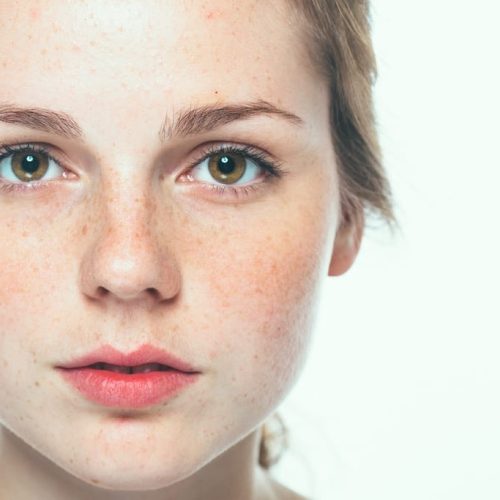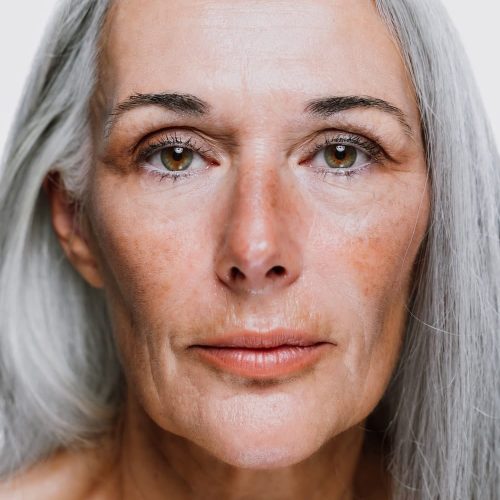
Hyperpigmentation occurs when excess melanin causes a darkened appearance to the skin in either small or large areas. Pigmentation is the natural colour of a person’s skin and it is related to melanin production. Melanin protects skin cells and their DNA by absorbing the sun’s ultraviolet rays. Darker skin types, in general, are more susceptible to hyperpigmentation than lighter skin types because their skin naturally contains more melanin.
Hyperpigmentation can appear in several forms, each with different causes. UV-induced hyperpigmentation shows up as freckles, age spots, and uneven skin tone due to sun exposure or tanning beds. Post-inflammatory hyperpigmentation occurs after skin trauma, acne, or irritation, where inflammation triggers immune cells that increase pigment production. Melasma, often hormone-related, appears as symmetrical patches on the cheeks, chin, upper lip, or forehead, and is commonly linked to pregnancy, birth control, or hormone therapy.
If you’re looking for treatments to help with hyperpigmentation on your skin, book a consultation to come and discuss your concerns. We will offer expert advice, answer your questions and recommend the right course of treatment for you.

EXCELLENTTrustindex verifies that the original source of the review is Google. Sarah at Finesse is an expert in her field. She is so knowledgeable about the latest techniques and products. I am delighted with the results and completely trust her her advice.Trustindex verifies that the original source of the review is Google. I went and booked for 3 skin peels it's the best thing I've done for my face it's made my skin look younger again and given me more confidence in the way my face looks. I also invested in the skin care it's absolutely amazing it's really is something else never used something that is so good and true to what it says. Beautiful setting and great skin care adviceTrustindex verifies that the original source of the review is Google. Lovely professional facility. Sarah is friendly, knowledgeable and obviously takes a lot of pride in what she does. She took the time to explain different procedures and followed the consultation up with additional messages and confirmation that she was there should I have any further questions. The consultation is held prior to any procedure and there is absolutely no pressure from Sarah to go ahead with any of the treatments suggested.Trustindex verifies that the original source of the review is Google. My visits to Finesse Skin Clinic have been truly transformative. Under Sarah’s expert care, incorporating Skinpen treatments with a bespoke probiotic skincare regime, my complexion has never been clearer and more resilient. Finesse Skin Clinic has the refined elegance of a Harley Street establishment, with immaculate, inviting interiors and impeccable cleanliness that immediately put you at ease. At every appointment, Sarah’s professionalism, warmth and deep understanding of skin science shine through, making each session both reassuring and effective. I always leave feeling confident and well cared for, thanks to her unwavering commitment to excellence.Trustindex verifies that the original source of the review is Google. Amazing! So kind and caring. I felt nervous but Sarah really took the time to explain everything in depth. Will be back soon.Trustindex verifies that the original source of the review is Google. Well what a lovely evening held by Sarah from Finesse Skin Clinic, the event was called Glowing Forward, and it was all about skin and the best way to look after it. Since receiving such a warm friendly welcome on arrival, we had some lovely healthy homemade snacks and refreshments before settling down to Sarah’s presentation. Well what can I say, very informative on how our skin works and ways in which we can help look after it, looking after it with supreme quality products and beauty treatments available to help be the best version of ourselves! Sarah was so professional and friendly, and really knowledgeable. We had plenty of products to sample & experience the effects on our skin, and an overwhelming amount of knowledge was passed on to us, which was super helpful for me, having recently had surgical menopause and being unwell my skin has become very unsettled. I left with a lot of knowledge and some essential starter kit products to help me on my journey to improve my skin! I really enjoyed the event I had a fantastic experience and feel I have more knowledge going forward and am looking forward to booking in with Sarah for a personal consultation, Thank you Sarah @ Finesse!Trustindex verifies that the original source of the review is Google. I attended the Clinics ‘Glowing Forward’ event and was blown away! Sarah has completely educated me about how to look after my skin, improve my skin and have the skin I always wanted. Sarah offers personalised 1:1’s to advise on what is right for you, I would HIGHLY recommend Finesse Skin ClinicTrustindex verifies that the original source of the review is Google. Sarah was so helpful, caring & reassuring. I had 2 treatments for a facial wart and would thoroughly recommend Finesse Skin Clinic.Trustindex verifies that the original source of the review is Google. I recently visited Sarah for a preventative Botox treatment, primarily focusing on my forehead lines, and I couldn't be happier with the entire experience and the wonderful results. Especially with it being my first time with this type of treatment. From the moment I met Sarah, I felt completely at ease. She is incredibly knowledgeable and clearly an expert in her field. She took the time to understand my goals – which were to prevent the signs of aging – Sarah explained the procedure in detail, ensuring I felt comfortable and informed every step of the way. The clinic itself was immaculate and located in a peaceful area, contributing to a very relaxing and professional atmosphere. The results gradually appeared between 3 and 10 days, and I am absolutely thrilled with how they look. My forehead lines especially have disappeared , and I feel a newfound sense of confidence. It's exactly the effective outcome I was hoping for. If you're considering preventative Botox or looking to address fine lines, I wholeheartedly recommend Sarah. Her expertise, combined with a clean and comfortable environment, made for a truly positive experience, and I am delighted with my results. I will certainly be returning in future.Trustindex verifies that the original source of the review is Google. Sarah is very sensitive to how much product is used which achieved a really natural look for me. Just what I wanted. So pleased.Verified by TrustindexTrustindex verified badge is the Universal Symbol of Trust. Only the greatest companies can get the verified badge who has a review score above 4.5, based on customer reviews over the past 12 months. Read more
Stay up to date with our latest news and promotions straight to your inbox.
Simply enter your details and spin the wheel for your chance to win a prize.
Our in-house rules: